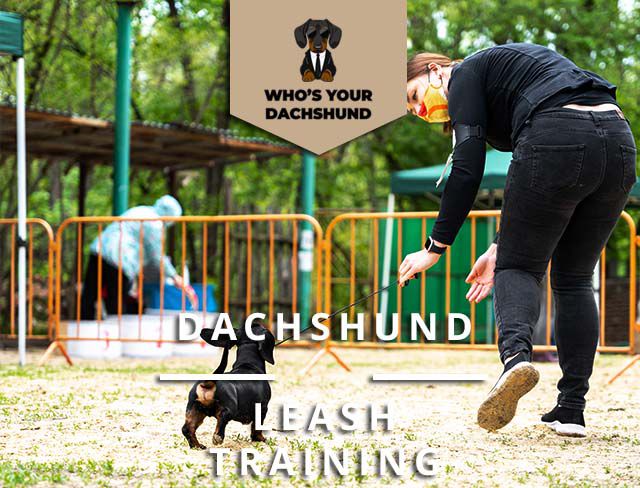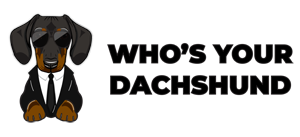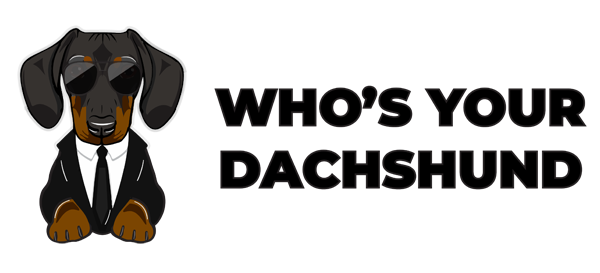
Dachshunds are intelligent, energetic dogs who like to roam. Leash training is essential for both you and your Dachshund.
- Start with your leash hooked up to the collar. Please put it on the floor in front of your dog’s nose as it eats its meal or drinks water from a bowl.
- Allow him to smell and examine the leash, but don’t let him play with it or chew on it until he’s done eating or drinking.
- As soon as your Dachshund has finished eating or drinking, set the leash down and walk away. Unless you’re making turns, entering and leaving your house, or taking a break from walking, keep it away from the dog at all times.
- When he begins sniffing the leash, reward him with praise or a treat and a pat on the head.
- You can grab the leash by putting one hand over it and the other beneath it if you want to let your dogs play with it before letting them go.
- Walk away with slow and measured steps until your pet lets go of the leash when you stop moving forward.
- Try to keep moving forward, and don’t allow your dog to tear around the room.
- When he gets to the end of the leash, turn in a circle and walk away from him. That will prevent him from pulling you in his direction when you’re done with the lesson or practice walk, or once you’re far enough from home that it would be dangerous to return to him before walking back inside.
- Make sure that when you turn back toward your Dachshund, you put just enough slack in the leash so that he doesn’t lunge at your feet with it again if desired.
- Practice walking your dog on a leash in various situations such as outside, in stores, and around other animals that might get startled by your Dachshund’s exuberance.
- Agility can help you develop a more confident, independent dog overall better off because of agility training.
Start Leash Training Your Dachshund Puppy
Start leashing training your Dachshund puppy. It’s never too early to start. A Dachshund pup’s leash training is not complicated, but it does require a little work on your part. The more you train your Dachshund pup from the very beginning, the easier the training goes.
You can train your pup in a few simple steps to walk on a leash.
- Attach the leash to your puppy’s collar and hold the leash in one hand as you walk in front of him.
- Let out about 3 feet of the leash and call his name or make some noise to get his attention. When he looks at you, praise him lots and give some love.
- Move behind him and release the leash another 3 feet, again getting his attention with your voice or a treat.
- Please put your hands on his shoulders and gently guide him forward. When he is walking calmly, praise him again.
Repeat the first few steps until your puppy will walk calmly on the leash. Every day or every other day, do this exercise while taking short walks with your Dachshund pup.
Why Would a Dachshund Refuse to Walk?
Some Dachshunds will refuse to stroll on a leash for several reasons:
- You may not have adequately trained the Dachshund on a collar and leash.
- The Dachshund may be frightened by something and refusing to move forward because it’s trying to get away from something specific that scares it.
- The Dachshund may be afraid of loud noises or other unleashed dogs.
- The Dachshund may be feeling too warm or too cold, and it refuses to move forward because it’s trying to cool itself down or warm itself up.
- The Dachshund may believe that it’s being dragged and is refusing to move forward in fear.
- The Dachshund may be suffering from a health problem that causes it discomfort, such as hip dysplasia (dysplastic hips), disk issues, thyroid problems, etc.
The more experienced you are with dogs, the easier it will be for you to determine which of these is the cause for your dog’s refusal to go along on the walk.
Injury or Pain
Injuries and pain can happen to any one of us at any time, and often they are unavoidable. However, there are ways to prepare for the possibility of injury or pain. The following is a list of things you can do to help prevent injury or pain during your training sessions.
- Ensure that your training area is large enough for you and your Dachshund to move about freely without the possibility of running into something, either accidentally or deliberately.
- Keep your training sessions short, and take breaks so your Dachshund can rest and mentally relax outside the crate if needed.
- Ensure that you are appropriately rested to not over-examine yourself at training time.
- Practice at a variety of times when possible because dogs are different, just like people are different in their circadian rhythm.
- Make sure that you are walking on a flat and level surface. If there are inclines, stairs, or rocks in your training area, you may want to walk on the ground instead of along the path or sidewalk.
- Ensure your dog is well-fed and hydrated before each training session so that he is neither hungry nor thirsty. That will decrease his motivation to eat during training time and will make him less likely to refuse commands to get something tasty from the owner after an exercise session.
- If your dog refuses to walk because of a lack of motivation, you may want to try working in front of a piggy bank or near a treat jar filled with tasty bits and pieces. This way, the dog can get some tidbits while learning a new command.
- When you see your Dachshund has stopped paying attention to you, stop moving forward and move backward until he is focused on you again.
- Do not yell at your Dachshund if he runs away from you or refuses to obey commands during training. It is not acceptable for humans to yell at a dog in this manner when training is taking place.
- If you see your Dachshund running toward you with excitement, stop moving forward and move backward until he comes to a controlled stop with soft paws. Then reward him with a tidbit or pat on the head.
12 Reasons Your Dachshund May Refuse to Walk on a Leash
Reason #1
His leash is too short.
Reason #2
He doesn’t like the feel of the leash around his neck and may resist it.
Reason #3
He doesn’t like the collar’s feel around his neck and may resist it.
Reason #4
He doesn’t like the feel of the harness around his chest and may resist it.
Reason #5
He is afraid of being restrained by a leash, collar, or harness when he may need to go potty in an emergency (Dachshunds are notorious for going potty every five minutes).
Reason #6
He is afraid of being restrained by a leash, collar, or harness when he may need to chase a squirrel.
Reason #7
He doesn’t realize that he will not chase cats/squirrels if you leash on him.
Reason #8
He is afraid of being restrained by a leash, collar, or harness and wants to escape it.
Reason #9
He is afraid of the other dogs and people he sees while on his walk and wants to get away from them all to feel calm and safe again in his doghouse.
Reason #10
He is afraid of the other dogs and people he sees while on his walk and wants to get away from them all to feel calm and safe again in his doghouse.
Reason #11
He is afraid of being held by a leash, collar, or harness when you carry him or carry his food/water bowl/poop bags around.
Reason #12
He likes to think that he is a big boy and can walk on command without any assistance (he is not)+
Types of Leash for Dachshund
A retractable leash
This kind of leash is an excellent option for Dachshunds that pull on leashes.
A standard leash
The leash may not be comfortable for pet owners since it does not retract.
A front-attachment harness & lead
If your pet has an aggressive personality, this is the best type to use because it allows you to control them without holding on tightly.
An over-the-shoulder sling or backpack chest harness with lead attached at chest level
This option is suitable for Dachshunds who are heavier or too small to wear a collar and give the owner more control than other options.
A slip collar or choke chain
It is a type of collar that tightens if you pull, but it’s not recommended because it could strangle your pet if they pull too hard and get stuck in something.
A martingale collar
A martingale collar works with a leash as you walk your dog through, making sure the collar is always loose enough not to choke your pet. If the dog pulls on this type of harness, the leash will tighten but not choke the dog.
You can choose the type of leash that’s right for your dog and personality.
There are a few different types, but the simplest is a flat nylon leash, sometimes called a “rope.” It works for most dogs. If you want to use one that stays out of the way and lets you keep a better eye on your dog, look into a retractable leash or collar. You can get these in flat nylon for the daytime and collapsible for nighttime use.
Warnings about using leashes include:
- Consider using a leash that’s comfortable for your dog.
- Get an adjustable one with a wide handle for your dog so it can’t pull away.
- Use training to help you teach your dog what’s okay to run off with a leash on before you leave the house together. Also, consider using an electric shock collar instead of pulling on the leash when he gets too far away from you, or the excitement begins to wear him out.
- Another way to train your dog is called “counter-conditioning.” That means that you reinforce them and make them want to do the same thing again in doing something good.
When choosing your dog’s harness, there are some things to consider:
- When picking your dog’s leash, you should make sure it fits them properly because if it’s too short, they’ll be uncomfortable, and if it’s too long, they could trip over it while walking.
- Ensure the leash doesn’t choke your dog when it gets scared or exciting.
- You should also ensure that the collar stays out of the way and doesn’t catch on objects while walking.
Are Dachshunds good off-leash?
On the question of whether or not Dachshunds are good off-leash, it depends on what you mean by “good.” Dachshunds can be very good at meeting people, and many people find their eagerness to greet strangers endearing. Many owners find this trait desirable and, if they are in a park, for instance, have no problem with letting their doxie wander away from them for a while.
Should I use a harness or a collar on my Dachshund?
Many people wonder, “What is the best collar for a Dachshund?”. A harness or collar? Depending on what you want your dog to do and what you need protection from, the answer could be yes or no. For a dog to pull a cart, for instance, you need a harness. However, if you want your dog to be safe at the beach or pool and not bite bystanders accidentally or on purpose, a collar is what you need.
So is the harness caused more damage to the neck?
Many people wonder whether or not a leash causes any harm at all on the neck of a dachshund. In short, it depends on how tight the leash is and where it touches your dog’s neck. If it touches a small part of the neck (like in between your fingers), then yes, it can cause some discomfort and minor damage in some cases. However, there is a risk of damage if a large amount of pressure is applied to a small neck area.

